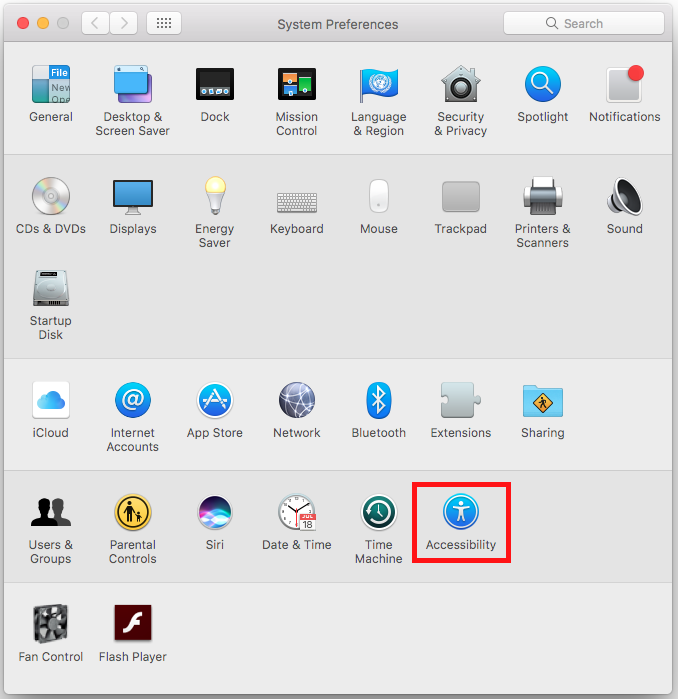- Changing mouse cursor appearance has certain benefits and fun filling as well. During presentations one need to animate the mouse to a larger size or make its shape or color different in order to improve the visibility of the mouse.There are many tools available to make stunning effects to change the appearance of the mouse cursor.Let us go through some of the change mouse cursor software.
- How To Change The Color: Customize Cursor On Mac Via Special Apps If you want to adjust your Mac’s cursor acceleration and sensitivity, consider using special applications. Such cursor effect apps can make your Mac’s mouse pointer look more vibrant, colorful, and unique. Let’s review some of them.
On your Mac, use the Mouse & Trackpad pane of Accessibility Pointer Control preferences to make your mouse and trackpad easier to use. The options available depend on the Mac you’re using. To change these preferences, choose Apple menu System Preferences, click Accessibility, click Pointer Control, then click Mouse & Trackpad. Changing mouse cursor size in MacOS is very simple, yet not always obvious procedure. Default cursor size satisfies almost every Mac user, but there are people out there who want to increase the system’s interface or cursor because of poor eyesight or simply because they do not like the default cursor.
The issue of mouse disappearance is not uncommon for Mac or PC users, no matter what kind of operating system you are using. This can be truly aggravating since most computer users rely way more on mouse compared to the keyboard to navigate around.
Contents
- 9 Restart your Mac
Where Did Your Cursor go?
When you notice it happens the first time, you might see that the cursor has disappeared all of a sudden. However, if you try to moving it to the left and right-clicking or dragging the mouse around, you’ll see that the device functions are still working, with the cursor simply going invisible.
Disappearing mouse cursor often happens due to one reason: the lack of memory space. Running out of available memory is usually caused by heavy applications such as video editing software or browsers. These programs hog relatively a lot of RAM space to function properly.
Additionally, it turns out that users with multi-monitor setup are mostly the victim of the disappearing pointer/cursor. Keep in mind that multiple displays setup won’t directly affect your RAM space since the display is largely managed by your GPU hardware. Rather, multi-monitor users are known to often multi-task, e.g., opening 50 tabs of Chrome while editing video at the same time, thus use more memory than the average users.
To address the issue of disappearing mouse cursor, there are few troubleshooting methods that you can try.
Try to right-click or shake the cursor using mouse or track pad
This would be the simplest solution that you should initially try. By either moving the cursor around or right-clicking, you may instantly recognize the location of the lost cursor. In this case, the cursor didn’t actually disappear. Instead, it might be deliberately hidden by an application to increase visibility when the mouse is not used for a set period or if you are doing a specific kind of activity.
Switch active app using the keyboard shortcut

If moving or clicking the mouse around doesn’t work, switch the active app using the keyboard by hitting Command + Tab together. This method can fix the problem if the bug is related to only specific apps instead of the whole system. If this does work for you, consider updating your app or use a different one.
Check to see if the mouse hardware is working properly
If you have a wireless mouse, there may be something wrong with the connection or the battery. Reconnect the USB receiver, recharge the battery, or try to use a different mouse if possible. That way, you can be sure it’s not the hardware that acting up.
Mouse pads can also affect mouse movement, especially if you are using an optical mouse. If you have an uneven or colorful mouse pad, try to replace it with a more smooth and plain black surface—you can also try to remove the mouse pad altogether—to see if it introduces any difference.
/001-make-mac-mouse-pointer-bigger-2260808_-b78aa10fdf2f40a4845fdad463183802.jpg)
Bring the cursor to the Dock
You might be confused about how you should move the cursor to the Dock—located at the bottom of your screen—if you can’t even see the cursor in the first place. However, you can drag your mouse or finger on the trackpad to the bottom, as if the cursor is there.
No matter where the cursor is supposed to be located, dragging it down would always make it reach the Dock. Once it is on the Dock, the pointer will most likely become visible.
Disable installed third-party screensaver
Third-party features often come as the culprit behind bugs when using any kind of computer. If you install any third-party screensaver, try disabling it for once or use the default screensavers provided by Apple.

Summon the Force Quit menu
Force Quit menu is generally used as an ‘escape hatch’ for Mac users who encounter any problem with some apps that seemingly have no visible exit. To summon the Force Quit menu, hold the Command + Option + Escape key at the same time.
Just like its name, Force Quit make it possible for you to forcefully end an app operation. But, you don’t actually need to end anything. Often, simply bring up the Force Quit menu is sufficient to make the cursor reappear.
Readjust the cursor size

Change Your Mouse Cursor Mac
Sometimes, it’s not that the cursor disappears, but rather, it’s too small for you to notice it. To re-adjust the cursor size, follow these steps:
- Open the System Preferences app.
- Head over to Accessibility.
- On the sidebar located on the left side of the window, choose Display.
- There, you should find a slider that controls the Cursor size from ‘Normal’ to ‘Large.’ Don’t forget to also enable Shake mouse pointer to locate in order to make the cursor temporarily bigger to make it more noticeable when shaken.
Restart your Mac
When in doubt, restart your computer. Rebooting has always been the go-to solution for any kind of problem you’re having with a device. Otherwise, these troubleshooting methods can help you solve the case of your missing mouse.
Related Posts:
Macos Change Mouse Cursor Color
Changing mouse cursor size in MacOS is very simple, yet not always obvious procedure. Default cursor size satisfies almost every Mac user, but there are people out there who want to increase the system’s interface or cursor because of poor eyesight or simply because they do not like the default cursor. Just a matter of taste, you know…
If you are one of these users and want to increase mouse cursor size on Mac, here is what you need to do. For some reason, Apple hides mouse cursor size slider within the accessibility settings, not inside the mouse/trackpad settings. We won’t focus on why it is there. This article rather shows you how to find mouse cursor size settings in macOS Mojave and how to increase it.
Do note that this instruction applies to macOS 10.14 Mojave and above, plus some previous releases. Apple may change something in the future so this article will be updated accordingly. If you want to increase mouse cursor size on Mac which works on very ancient macOS, a procedure may be a bit different.
- Open System Preferences. This “app” is located inside the Apple menu in the top-left corner of the screen.
- Alternatively, you can open System preferences inside the Launchpad.
- Open Accessibility section.
- Now select Display in the left panel.
- Now adjust the Cursor size slider. A cursor will change its size in the real-time, so no need to restart your Mac.
- Everything is done.
Change Mouse Cursor Color Mac
Here is an additional thing to note. Take a look at the Shake mouse pointer to locate. This checkbox (it is enabled by default) allows you to quickly find your lost cursor. If your screen is very big and you can’t find this tiny black pointer, just shake the mouse or trackpad quickly, and Mac will increase mouse cursor size so you can find it easily. Not everyone knows about this nifty trick, but now you do.

Unfortunately, there are not so many cursor settings to customize. In this case, Windows provides much more options and you can check how to increase cursor size on Windows 10 in the separate article.
